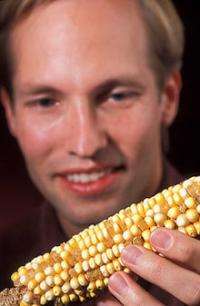Edward Buckler reported at the annual AAAS meeting that powerful genome sequencing tools can now help researchers exploit the genetic diversity of crops to improve productivity, sustainability and nutrition.
(PhysOrg.com) -- Using powerful genome sequencing tools created for human genetics, researchers can now exploit the genetic diversity of crops to improve productivity, sustainability and nutrition, a Cornell researcher reported Feb. 19 at the annual American Association for the Advancement of Science meeting in Washington, D.C.
Researchers now have the tools to dissect maize genes, for example, and predict the likelihood of any trait with up to 90 percent accuracy, said Edward Buckler, a U.S. Department of Agriculture--Agricultural Research Service research geneticist in Cornell's Institute for Genomic Diversity, in his presentation, "Dissecting the Genetics of Complex Agronomic Traits for Crop Improvement."
"There are some simple traits, like improving vitamin A content in maize, that work with five or 10 genes, but we can also understand complex traits, like flowering time, that work with over 50 genes, and we can still make very accurate predictions," said Buckler, a Cornell adjunct associate professor of plant breeding and genetics. The researchers have discovered that with such complex traits, individual alleles (or gene variants) each have very small effects, but together they can create a large effect.
Maize has more natural variation in its genes than humans and apes combined, Buckler said. To understand variation, researchers focus on single nucleotide polymorphisms (SNPs), points in the genetic sequence where there is a mutation within a single base pair. While many of these SNPs have no effect, Buckler estimated that corn may still have hundreds of thousands of SNPs with functional effects. By growing out special populations of plants -- something not possible with human genetics -- and then measuring millions of individuals, researchers can explain most of the variation, Buckler said.
With the ability to explain variation and accurately predict which traits exist in a plant, breeders can now cross two plants and predict which offspring will have the traits they desire, without having to grow out tens of thousands of plants. Using genetic markers is much cheaper and cuts the time to advance new varieties to four months for annual species like maize; traditional methods can take five years.
In the coming decades, breeders hope to use genomic tools to create crops that produce twice the yield with the same amount of fertilizer and water; that grow perennially; are drought resistant and utilize nutrients more efficiently; and are biofortified to improve nutrition in the developing world, Buckler said.
"Now is the time to apply these tools to important traits to improve society and sustainability," he said.
Provided by Cornell University






















